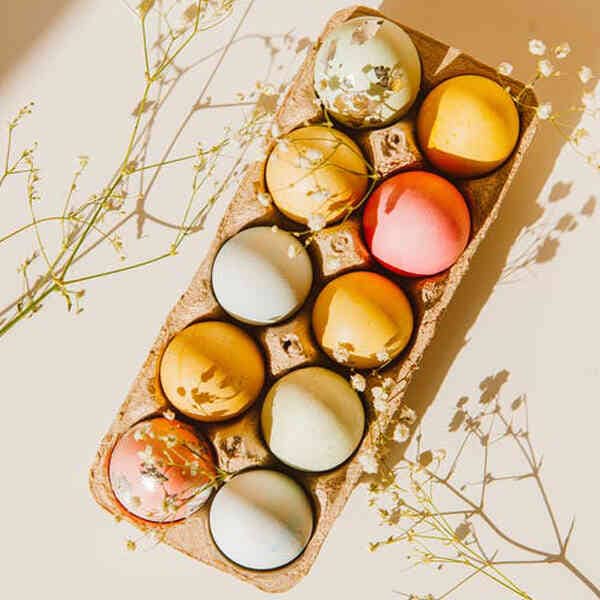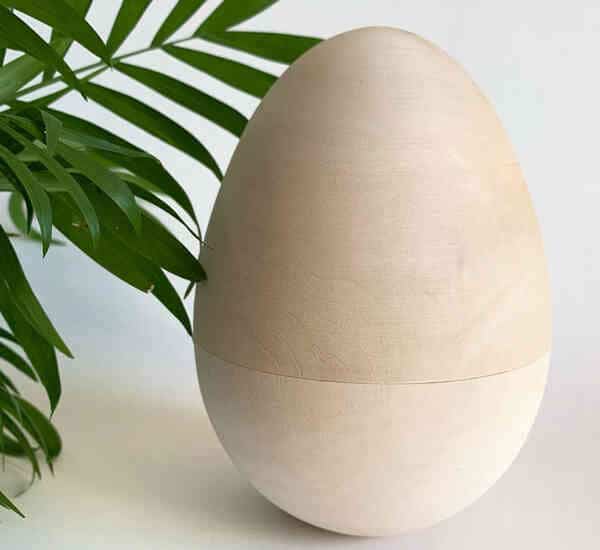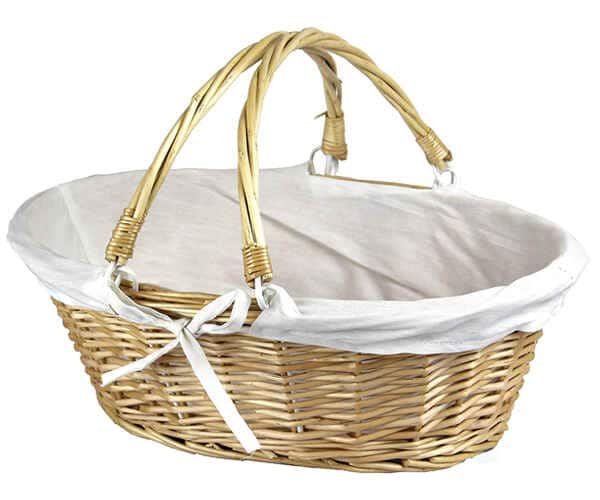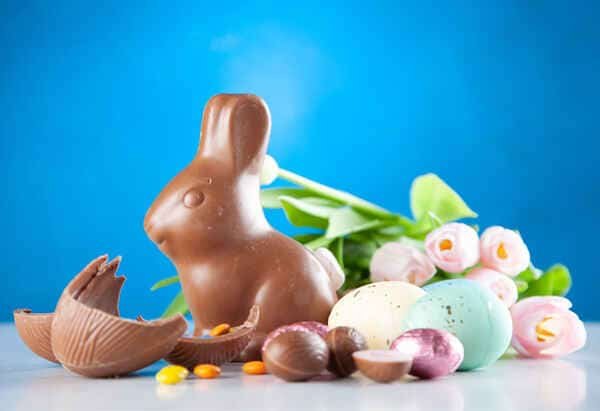13 Money-Saver Sustainable Easter Ideas
As an Amazon Associate, Ecotero earns from qualifying purchases.
Today, we will share a dozen and one sustainable Easter tips that will significantly minimize your and your family’s negative impact on the environment.
As you may already know, Easter is a joyous time of the year but is also a wasteful celebration.
Tons of plastic Easter eggs, chocolate packaging, and discarded Easter decorations are bound to landfills immediately the day after the festivities.
And let’s not forget the hundreds (if not thousands) of uneaten hard-boiled eggs and other wasted food during this spring holiday.
As a conscious individual, you might be asking yourself:
“Is there a way to celebrate a more sustainable Easter?”
Well, that’s an “eggcellent” question!
Below are 13 ideas to celebrate an eco-friendly Easter and save money at the same time.
1. Buy Locally-Produced Eggs
One of the most beloved traditions during Easter is dying eggs.

But the next time you purchase several dozens of eggs for dying, choose to buy eggs that are produced locally or within your area.
We know it can be tempting to grab the biggest eggs you can find, but locally-produced eggs haven’t been shipped from thousands of miles.
Thus, they have a far less carbon footprint compared to imported eggs.
And since locally-produced eggs are not transported from thousands of miles away, they’re probably much cheaper.
2. Use Natural Dyes for Easter Eggs
Store-bought dyes contain chemicals that can accumulate and pollute natural water ecosystems.
Since they are foreign substances, the dye chemicals can potentially have harmful effects on fishes and aquatic organisms if they build up over time.
Although there is no solid evidence that dyes hurt fishes, they can affect marine plants that fish and other aquatic life may use for food and habitat.
And did you know that dyes are among the harmful ingredients in personal care products you must avoid?
Dyes can seep into the hard-boiled eggs which you and your family will then eat.
Instead of using chemical dyes from stores, you can use flower petals, vegetables, fruits skins, and produce leftovers to dye Easter eggs naturally.
Most of them are basically free as they are bound for trash, so you’re avoiding harmful chemicals and unnecessary expenses at the same time.
Here’s how:
3. Buy Locally-Sourced Food Ingredients
Besides eggs, buy locally sourced ingredients for your Easter recipes as well.
Whether you’re planning to make hot cross buns, roast lamb, ham, or another traditional Easter food…
It is much better for the planet if you minimize using ingredients produced halfway across the world.
Locally-sourced food ingredients are likely cheaper too!
4. Use Plastic Free Easter Eggs
If you’re hoping for a plastic free Easter or at least looking to reduce your plastic waste, then this is for you.
At some point, you might have asked yourself:
What can I use instead of plastic Easter eggs?
Plastic Easter eggs are costly and they end up in landfills.
Fortunately, you have plenty of Earth-friendly options.
Some of the most eco-friendly Easter eggs you can use are wooden eggs or wool felted eggs.

You can also search online for “plastic free Easter eggs” or “eco-friendly Easter eggs” to get more sustainable Easter egg options.
5. Minimize (Avoid if possible) Using Real Eggs as Decorations
This might be contradictory to the first two tips on this list, but hear us out.
While we understand that dying and decorating your house with real eggs are fun, they go bad pretty quickly.
Take a moment and think about how many hard-boiled eggs will be tossed and wasted this Easter.
So instead of using real eggs, why not use solid wooden eggs as decorations?

You can buy plain wooden eggs in your local store or online, and you can paint and dye them yourself.
They may require a higher initial investment, but wooden Easter egg decorations never spoil.
You can store them after Easter this year and reuse them again in the coming years, thus saving you money in the long run.
And when they reach the end of their usable life, you can compost wooden Easter eggs as they are entirely biodegradable.
6. Use Eco-Friendly Easter Baskets for Kids
Easter baskets for kids, what do you have in mind?
Instead of shopping for the usual Easter baskets made of plastic, consider buying wicker baskets or other alternatives made with naturally sustainable materials.

Because the sad reality is most Easter baskets are never used again after Easter.
They are either discarded, which will eventually become another plastic waste in landfills.
A much cheaper sustainable Easter basket idea is to make one for your kids using paper.
DIY Paper Easter Basket Idea
All you need to make a paper Easter basket are A4 paper, scissors, and glue.
And even if you’re not that artistic or crafty, this idea is so simple that you can make one paper Easter basket in less than an hour!
Here’s how:
7. Use “Greener” Grass
Besides eggs, Easter baskets are also typically filled with shreds of green grass made with plastic.
And just like many plastic accessories during Easter, they will be thrown away after the festivities.
So this year, why not decorate your kid’s Easter basket with nonplastic grass?
You can use green recycled paper cut with scissors.
You can also use actual grass from the fields, branches, or twigs.
Another eco-friendly Easter grass option is green yarn.
For more eco-friendly Easter basket filler ideas, check out this post by Eco Mom Diaries.
8. Buy Fair Trade Chocolate Eggs
Chocolate eggs are a big part of the Easter celebration.
But did you know that despite their sweetness, chocolates have a secret “dark” side to them?

We are talking about slavery, child labor, and the terrible working conditions rampant in the chocolate production industry.
So this Easter, help improve the condition of the chocolate industry workers by supporting Fair Trade chocolate brands.
Fair Trade chocolates are made with cacao beans sustainably grown, harvested, and sourced from farmers who are paid a fair price and treated ethically for their labor.
Many fair trade chocolates are also organic, meaning the cocoa beans they are made with are grown without pesticides.
And if your concern is that Fair Trade chocolates are expensive, then you don’t have to worry.
Many ethical and fair trade chocolate brands are also selling much cheaper products.
9. Don’t Buy Brand New Easter Outfit for Kids
We understand that kids dressed in vibrant colors are a sight during Easter.
However, shopping for new clothes for kids just for Easter is not eco-friendly or practical.
Clothes are really hard to recycle, and many old clothes aren’t repurposed either.
Around 85% of thrown clothing in the US is dumped in landfills or burned, which translates to more waste and pollution.
So if possible, just let your kids wear the colorful clothes they already own this Easter.
Most of them won’t even complain, and you can save some serious bucks.
But if you have to buy an Easter outfit for kids, there’s an eco-friendly and thrifty way to do it.
10. Shop Sustainable Easter Outfits
While shopping for new clothes just for Easter isn’t sustainable, there are different ways to be eco-friendly about it.
- Buy second-hand kids’ clothes from thrift shops.
- Shop kid clothes from eco-friendly clothing brands.
- Buy high-quality clothes made of sustainable materials (e.g., bamboo, hemp, organic cotton).
11. Avoid Food Waste
We understand that there’s a spirit of abundance associated with Easter.
But do keep in mind that wasted food means wasted resources and wasted money.
Moreover, rotting food is harmful to the planet as they emit greenhouse gases that contribute to global warming.
So this Easter, only prepare the exact amount of food you, your family, and visitors can consume.
Also, don’t go overboard with hard boiling eggs.
With all the delicious food you prepare, there’s a good chance that you won’t be able to eat a lot of hard-boiled eggs.
12. Use Plastic Free Containers to Store Leftover Easter Foods
In the case of leftover foods, store them using aluminum, stainless steel, or silicone lunch boxes as they are generally more eco-friendly than plastic lunch boxes.
They are also much safer than plastic as they don’t leak harmful chemicals like BPA.
Also, instead of using single-use plastic cling wraps, use beeswax food wraps as they are biodegradable and reusable.
Better yet, give away your excess food to homeless people and spread the love this Easter.
And the final sustainable Easter tip we have for you is…
13. Drive Less to Minimize Carbon Emissions
The transportation sector is one of the top contributors to air pollution and carbon emissions.
Why not do mother Earth a huge favor this Easter by not using your car?
Of course, we don’t mean this in any way that causes inconvenience for you and your family.
But here are some tips to minimize your carbon emissions this Easter and onwards:
- Pick up supplies for Easter in bulk; the less trip you make to the store, the better
- Instead of using your car, ride the train, bus, or any public transportation
- Carpool or ride Uber with your friends when going to Easter dinner alone
- Take a hike towards your destination whenever you can
Final Thoughts on Celebrating a Sustainable Easter
As you’ve just learned, you don’t have to be wasteful to enjoy Easter with your family and relatives.
There are simple things you can do this Easter that will have a positive impact on the planet.
Even better, they can even save you some money!
Anyways, which money-saver sustainable Easter tip is your favorite?
Which one would you start with?
Meanwhile, if you have more eco-friendly Easter ideas, you can share it in the comments below for our readers to read.
